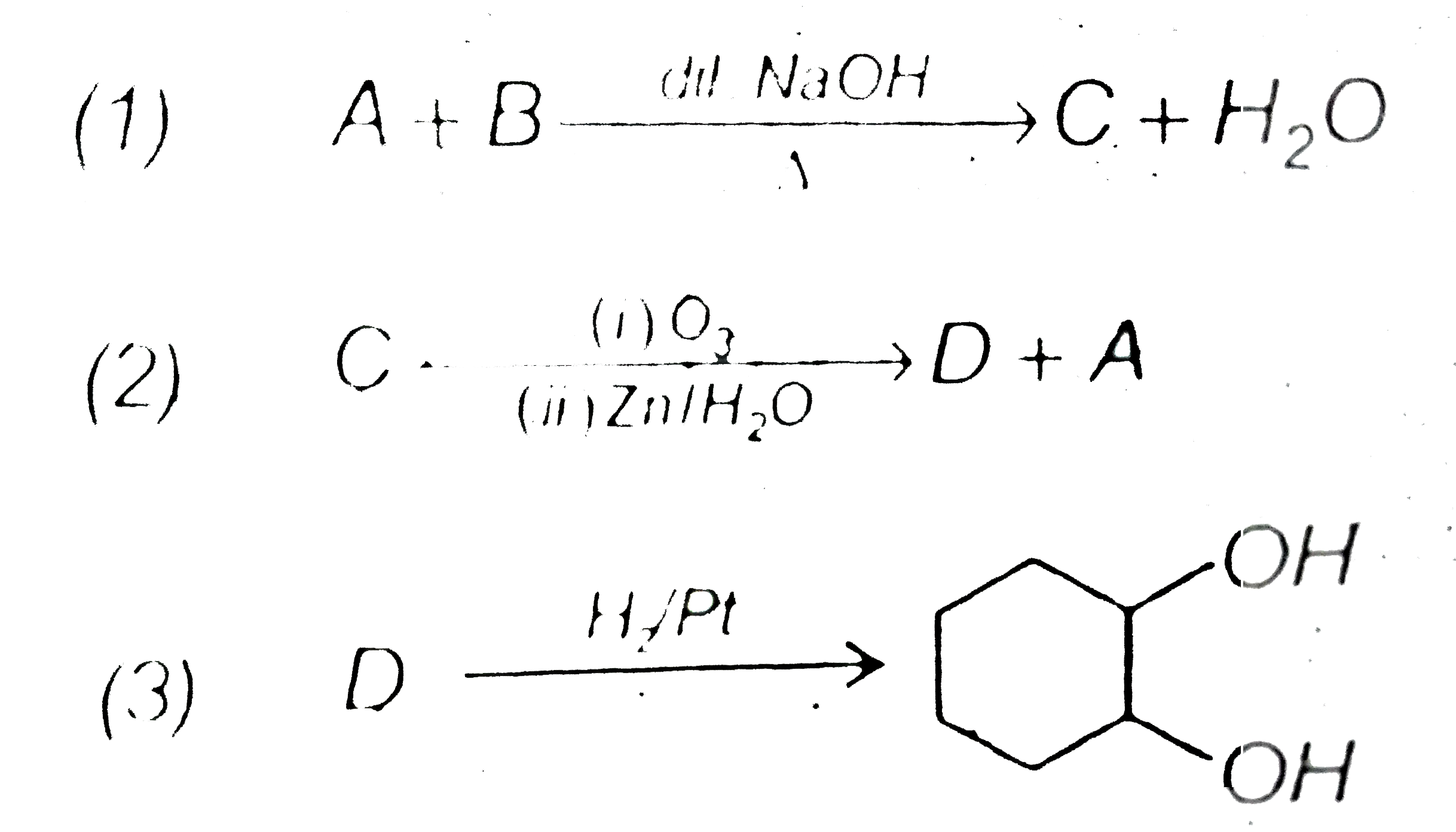If electronegativity of element A,B,C & D
are 1.2, 3, 1.8 & 2.8 respectively then
which of the following hydroxide is most
basic in nature in aqueous solution:-
Question Type: Single Correct Type
(1)
A-O-H
(2) B-O-H
(3)
C-O-H
(4)
D-O-H
Video Solution
Text Solution
(i) CH3CH2IIodoethaneNaCN−−−→−NaICH3CH2CNPropanenitrile (A)OH−−−−−−−−−−−−→(Partial hydrolysis)CH3−O∣∣C−NH2Ethanamide (B)NaOH+Br2−−−−−−−−−−−−−−−−−−−→(Hofmann bromamide reaction)CH3−NH2Methanamine (C)
(ii) C6H5N2ClBenzenediazonium chlorideCuCN−−−−−−−−−−−−−→(Sandmeyer reaction)C6H5CNBenzonitrileH2O/H+−−−−−→HydrolysisC6H5COOHBenzoic acid (B)[C6H5COONH4]Δ−−−→−H2OC6H5CONH2Benzamide (C)
(iii) CH3CH2BrBromoethaneKCN−−→CH3CH2CNPropanenitrile (A)LiAlH4−−−−−−−→(Reduction)CH3CH2CH2NH2Propan-1-amine (B)HNO2,0%−−−−−−−−−→(Diazotisation)[CH3CH2CH2+N≡NCl−]H2O−−−−−−−→−N2,−HClCH3CH2CH2OHPropanol (C)
(iv) C6H5NO2NitrobenzeneFe/HCl−−−−−−−→(Reduction)C6H5NH2Aniline (A)NaNO2+HCl−−−−−−−−→273KC6H5+N≡HCl−Benzenediazonium chloride (B)H2O/H+−−−−−→ΔC6H5OHPhenol (C)
(v) CH3COOHEthanoic acidNH3−−→ΔCH3CONH2Ethanamide (A)NaOBr−−−−−−−−−−−−−−−−−−→(Hofmann bromamide reation)CH3CH2Methanamide (B)NaNO2/HCl−−−−−−−→CH3OHMethanol (C).

|
Topper's Solved these Questions
- ORGANIC COMPOUNDS CONTAINING NITROGENBOOK - PRADEEPCHAPTER - ORGANIC COMPOUNDS CONTAINING NITROGENEXERCISE - NCERT EXEMPLANAR PROBLEMS WITH ANSWERS, HINTS AND SOLUTIONS (MUTIPLE CHOICE QUESTIONS-I)
27 Videos
- ORGANIC COMPOUNDS CONTAINING NITROGENBOOK - PRADEEPCHAPTER - ORGANIC COMPOUNDS CONTAINING NITROGENEXERCISE - NCERT EXEMPLANAR PROBLEMS WITH ANSWERS, HINTS AND SOLUTIONS (MUTIPLE CHOICE QUESTIONS-II)
10 Videos
- ORGANIC COMPOUNDS CONTAINING NITROGENBOOK - PRADEEPCHAPTER - ORGANIC COMPOUNDS CONTAINING NITROGENEXERCISE - NCERT QUESTIONS AND EXERCISES WITH ANSWERS (NCERT INTEXT UNSOLVED QUESTIONS)
9 Videos
- HALOALKANES AND HALOARENESBOOK - PRADEEPCHAPTER - HALOALKANES AND HALOARENESEXERCISE - IMPORTANT QUESTIONS FOR BOARD EXAMINATION
22 Videos
- P-BLOCK ELEMENTS BOOK - PRADEEPCHAPTER - P-BLOCK ELEMENTS EXERCISE - IMPORTANT QUESTIONS FOR BOARD EXAMINATION
25 Videos
Similar Questions
Knowledge Check
The E.N. of H,X,O are 2.1,0.8 and 3.5 respectively comment on the nature of the compound H−O−X, that is :
ABasicBAcidicCAmphotericDCan't be predictedThe electronegativities of four elements A, B, C, D are 4,3.17, 0.7 and 2.85 respectively and the electronegativities of hydrogen (H) and oxygen (O) atoms are 2.1 and 3.5 respectively.
Which of the following bonds is most polar?AB-CBA-DCB-DDC-DThe electronegativities of four elements A, B, C, D are 4,3.17, 0.7 and 2.85 respectively and the electronegativities of hydrogen (H) and oxygen (O) atoms are 2.1 and 3.5 respectively.
Which of the following bonds is most polar?AB-CBA-DCB-DDC-D
Which of the following has larger bond angle in the following pairs ?
(a)NH3,PH3(b)BeF2,BF3(c)H2O,CO2(d)H2O,H2S(e)CCl4,C2H2 ?
View SolutionWrite the possible isomes for the following molecuar formulae.
(a) C4H8O ( b) C3H6O2 ( c) C5H12O
View SolutionIdentify A-D in the following reactions .

(1) A+BdilNaOH−−−−−→ΔC+H2O
(2) CdilNaOH−−−−−−−→(ii)Zn/H2OD+A
(3)
View SolutionThe electronegativities of four elements A, B, C, D are 4,3.17, 0.7 and 2.85 respectively and the electronegativities of hydrogen (H) and oxygen (O) atoms are 2.1 and 3.5 respectively.
Which of the following bonds is most polar?
View SolutionWhich of the following are green house gases ? (a) CO2 (b) O2 (c) O3 (d) CFC (e) H2O
View Solution
